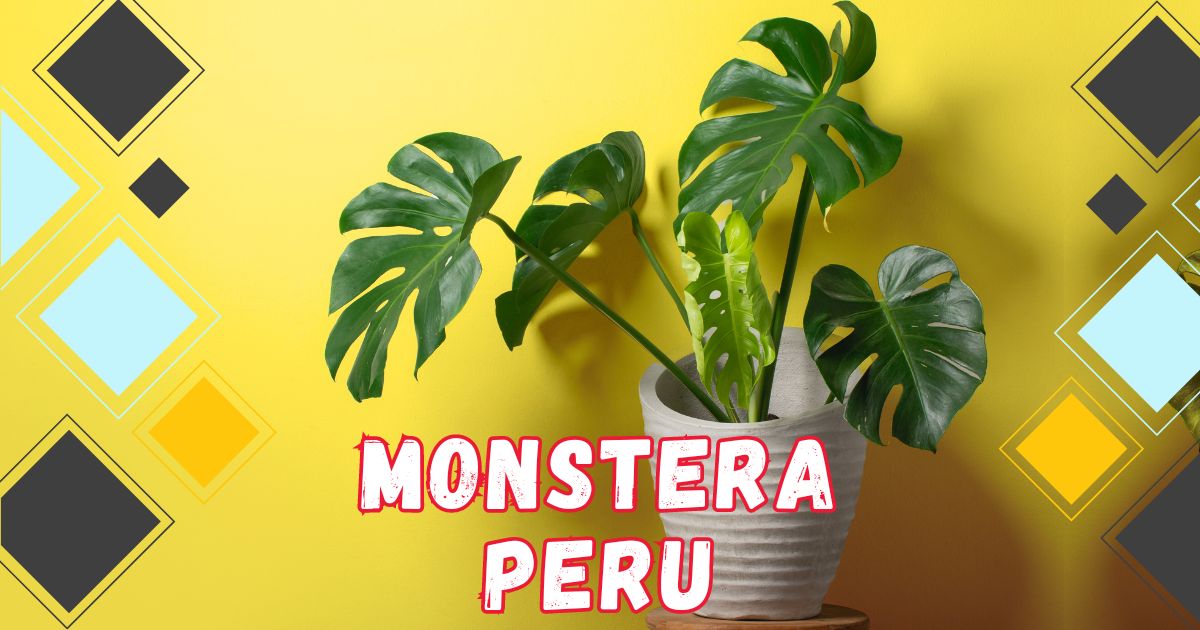The Monstera Peru, also known as Monstera Karstenianum, is a stunning, low-maintenance houseplant prized for its thick, textured leaves and easy-going nature. This exotic plant has gained popularity among plant enthusiasts thanks to its unique appearance and relatively straightforward care needs. In this article, we’ll cover 5 essential care tips for Monstera Peru, explore how it stands out from other Monstera species, and offer practical advice on watering, lighting, propagation, and more to help your plant thrive.
What is Monstera Peru? A Complete Overview of This Stunning Plant
Monstera Peru is part of the Araceae family and is native to the tropical regions of Central and South America, particularly in Peru. It is often referred to as a climbing plant, though it differs from the more well-known Monstera Deliciosa. One distinguishing feature is its thick, glossy leaves with a deep green color and intricate texture, giving it a distinct, almost leathery appearance.
Unique Characteristics of Monstera Peru
- Textured Leaves: Unlike the fenestrated (split) leaves of Monstera Deliciosa, this plant has smooth but heavily textured leaves, resembling a reptile’s skin.
- Compact Growth: This plant grows more compactly compared to other Monstera species, making it an excellent choice for small spaces.
- Climbing Nature: As a natural climber, this plant can grow along a trellis or support, making it ideal for vertical displays.
Monstera Peru vs. Other Monstera Species: How It Stands Out
While many Monstera varieties are beloved for their split leaves or holey patterns, this plant is unique because of its thick, non-split foliage. Here’s how it compares to some of the more common Monstera species:
1. Monstera Peru vs. Monstera Deliciosa
The Monstera Deliciosa, also known as the Swiss cheese plant, is famous for its large, fenestrated leaves. In contrast, it has thicker, non-fenestrated leaves with a leathery texture. Additionally, the Peru variety grows more compactly and is more manageable for indoor growing.
2. Monstera Peru vs. Monstera Adansonii
The Monstera Adansonii, also known as the ‘Swiss cheese vine,’ has smaller leaves with numerous holes. Its leaves are solid, without any natural fenestrations, making them look sturdier and more substantial.
3. Monstera Peru vs. Monstera Obliqua
The Monstera Obliqua is much rarer and has extremely delicate leaves with large holes. In comparison, this plant is much easier to care for and has a tougher leaf structure, making it more suitable for beginner plant parents.
How to Water Monstera Peru: Best Practices for Optimal Growth
Watering your Monstera Peru properly is key to its overall health and growth. Like many tropical plants, it enjoys consistent moisture, but overwatering can lead to root rot, one of the most common issues with this plant.
Watering Guidelines for Monstera Peru
- Watering Frequency: Water this plant once the top 2-3 inches of soil feel dry to the touch. Depending on your environment, this may mean watering every 7-10 days.
- Avoid Overwatering: Ensure that your pot has good drainage to prevent water from sitting at the bottom, as excess water can lead to root rot. If you notice yellowing leaves or mushy stems, it’s a sign of overwatering.
- Humidity Considerations: Since the plant is native to tropical climates, it thrives in high humidity. You can increase the humidity by misting the leaves or placing the plant near a humidifier, especially during dry seasons.
Lighting Requirements for Monstera Peru: Finding the Perfect Spot
This plant thrives in bright, indirect light. While it can tolerate lower light conditions, it will grow more slowly, and its leaves may lose some of their characteristic vibrancy.
Ideal Lighting for Monstera Peru
- Bright, Indirect Light: Place your Monstera Peru near a window where it can receive bright, filtered light. Direct sunlight can scorch its delicate leaves, so be sure to avoid placing it in full sun.
- Low Light Tolerance: While Monstera Peru can tolerate low light, it won’t grow as vigorously. If you notice your plant becoming leggy or stretching toward light sources, consider moving it to a brighter location.
- Artificial Lighting: If you live in a space without ample natural light, grow lights can be used to supplement your Monstera Peru’s light requirements.
How to Propagate Monstera Peru: Step-by-Step Guide
One of the joys of owning this plant is the ability to propagate it, allowing you to grow new plants from cuttings. The process is simple and can be done either in water or soil.
Propagation Steps
- Select a Healthy Stem: Choose a healthy stem with at least one node (the point where the leaf meets the stem). Ensure the cutting is about 4-6 inches long.
- Cut Below the Node: Using clean scissors, cut just below a node. This is where new roots will form.
- Water Propagation: Place the cutting in a jar of water, making sure the node is submerged. Change the water every few days and wait for roots to form, which can take 2-4 weeks.
- Soil Propagation: Alternatively, you can plant the cutting directly in moist, well-draining soil. Keep the soil consistently damp but not soggy, and place the pot in bright, indirect light.
- Transplant Once Rooted: Once the roots are about 1-2 inches long, transplant the cutting into a pot with well-draining soil and continue normal care.
Common Problems with Monstera Peru and How to Fix Them
Like any plant, Monstera Peru can encounter problems. However, most issues can be avoided with proper care. Here are some common problems and solutions:
1. Yellowing Leaves
Yellowing leaves are often a sign of overwatering. If the soil is too wet or lacks proper drainage, roots can become waterlogged and rot. To fix this, reduce watering and ensure that the pot has adequate drainage.
2. Brown Leaf Tips
Brown tips can indicate underwatering or low humidity. Make sure your plant is receiving enough water, and increase the humidity around it if necessary by misting the leaves or using a humidifier.
3. Leggy Growth
If your plant becomes leggy or stretched out, it’s likely not receiving enough light. Move the plant to a brighter location with indirect sunlight to encourage fuller growth.
4. Pests
This plant is generally resistant to pests, but it can occasionally suffer from spider mites, mealybugs, or aphids. Regularly inspect the leaves for signs of pests, and treat infestations with a mild insecticidal soap or neem oil.
Soil and Fertilizer: How to Keep Your Monstera Peru Happy
Providing the right soil and nutrients is essential to the health of your plant. Using the correct soil mix and fertilizing regularly will encourage strong, healthy growth.
Soil Requirements
This plant thrives in well-draining soil that allows excess water to flow out while retaining enough moisture for the roots. A mix of peat, perlite, and orchid bark works well for this plant.
- Aeration: The soil should be light and airy to allow oxygen to reach the roots.
- Drainage: Use a pot with drainage holes to prevent water from sitting at the bottom, which can lead to root rot.
Fertilizing Monstera Peru
Monstera Peru benefits from regular fertilization, especially during the growing season (spring and summer).
- Type of Fertilizer: Use a balanced liquid fertilizer diluted to half-strength. Fertilize once every 4-6 weeks during the growing season.
- Avoid Overfertilizing: Overfertilization can cause leaf burn or damage the roots, so it’s important to stick to a light feeding schedule.
Looking for more tips on plant care? Check out our guide on 5 Proven Tips to Care for Your Thanksgiving Cactus and Make It Bloom! for expert advice on nurturing your indoor plants.
Conclusion: Caring for Your Monstera Peru
The Monstera Peru is a fantastic plant for both novice and experienced plant enthusiasts alike. Its unique, textured leaves and easy-going care requirements make it a beautiful addition to any indoor space. By following proper care guidelines for watering, lighting, soil, and propagation, you’ll enjoy a thriving plant that adds a touch of the tropics to your home.
Whether you’re looking to propagate new plants, solve common issues, or Simply enhance the growth of this plant, and it can offer years of satisfaction with the right attention. From its beautiful aesthetic to its manageable care routine, the Monstera Peru is truly a gem for plant lovers.
FAQs
- What is Monstera Peru?
This is a tropical climbing plant with thick, textured leaves, prized for its striking appearance and ease of care. - How often should I water my Monstera Peru?
Water your plant when the top 2-3 inches of soil feel dry, usually every 7-10 days, depending on humidity and temperature. - Can Monstera Peru tolerate low light?
While this plant can survive in low light, it thrives best in bright, indirect light for optimal growth and vibrant leaves. - How do I propagate Monstera Peru?
You can propagate the plant using a stem cutting with a node, placing it in water or directly into soil until roots develop. - Why are the leaves of my Monstera Peru turning yellow?
Yellow leaves are usually a sign of overwatering or poor drainage. Allow the soil to dry out between waterings and ensure proper drainage. - What type of soil is best for Monstera Peru?
This plant thrives in well-draining soil with a mix of peat, perlite, and orchid bark for aeration and moisture retention. - How do I increase humidity for my Monstera Peru?
You can increase humidity by misting the plant, using a humidifier, or placing it near other plants to create a micro-humidity environment. - Is Monstera Peru safe for pets?
Like other Monstera species, Monstera Peru is toxic to pets, so keep it out of reach of cats and dogs. - Can I grow Monstera Peru outdoors?
Monstera Peru can be grown outdoors in warm, tropical climates, but it must be protected from direct sunlight and cold temperatures. - Do I need to fertilize Monstera Peru?
Yes, fertilize your Monstera Peru during the growing season (spring and summer) with a balanced liquid fertilizer diluted to half-strength.

Joseph Bush is a seasoned writer and researcher with over 7 years of experience covering a wide range of general topics, from lifestyle and technology to business and current events. He is dedicated to producing fact-checked, reader-friendly content that informs, engages, and empowers readers.
Throughout his career, Joseph has followed strict editorial guidelines, relied on reputable sources, and ensured every article meets the highest standards of accuracy and clarity. His expertise spans multiple fields, allowing him to explain complex topics in a way that’s easy to understand.
Passionate about continuous learning, Joseph stays updated on industry trends and best practices to deliver trustworthy, well-rounded insights. Readers can rely on his work for its credibility, depth, and real-world relevance.




